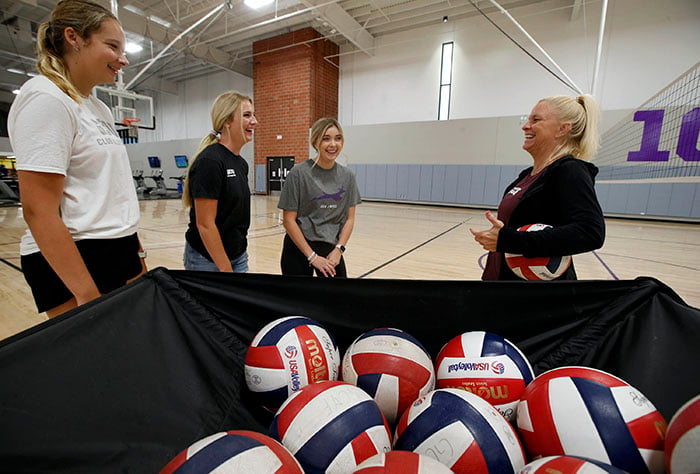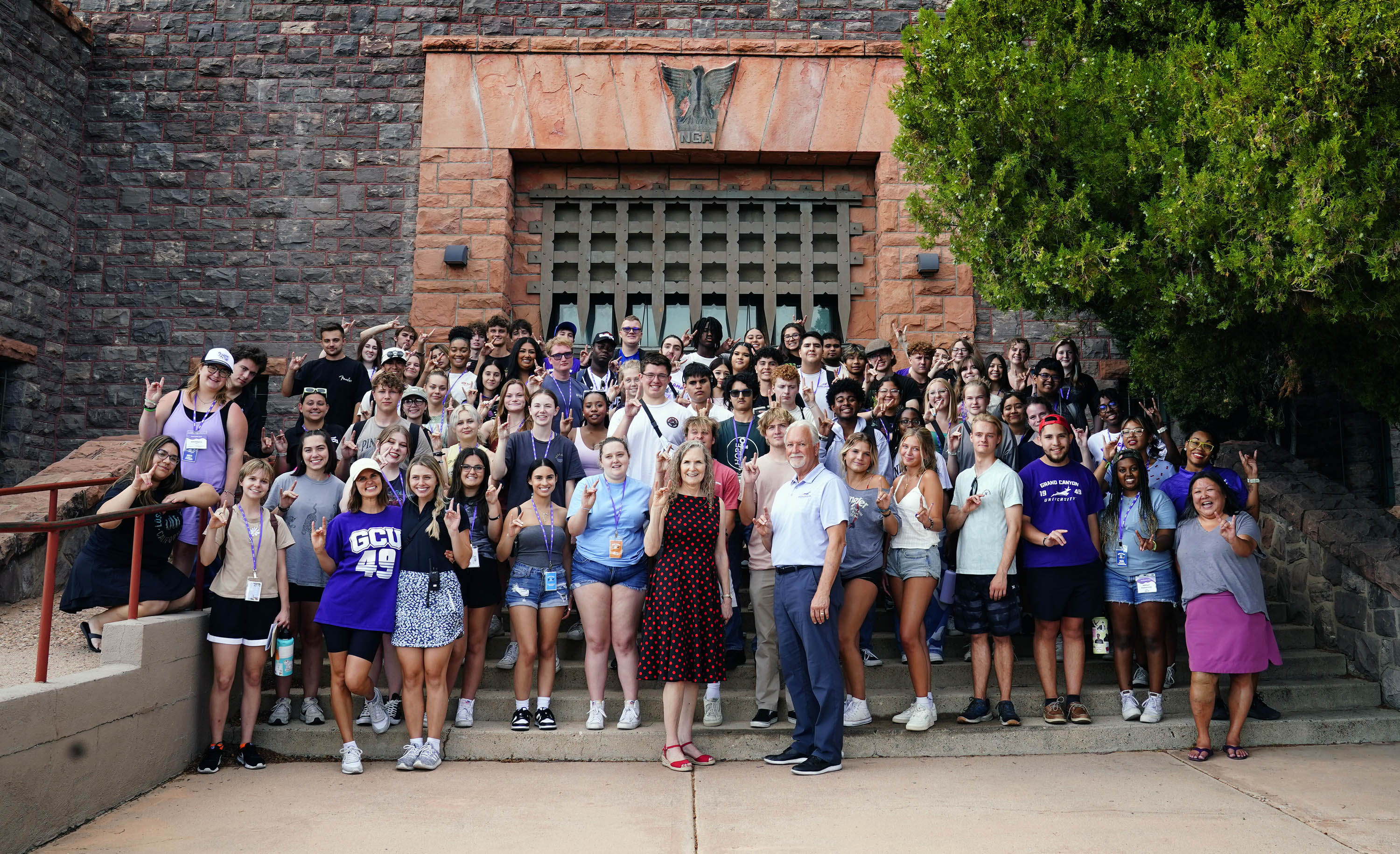
By Lana Sweeten-Shults
GCU News Bureau
TEMPE, Ariz. — A print head programmed to follow the preset coordinates of a digital blueprint squeezes out a layer of specialized concrete mix, like frosting on a cake. Then it gingerly tracks back in the opposite direction, spreading another concrete layer, smooth as butter, then another, building up layer after layer.
After a few hours, the layers form a gray wall that, as it turns out, isn't any mere wall.
It’s part of the framework for the first 3D-printed Habitat for Humanity home in the United States — a home that could be a game-changer when it comes to affordable housing.

The 3D-printed house, under construction in Tempe, is far from the keychains and other gifts and trinkets Grand Canyon University sophomore robotics and engineering major Kylee Rodgers churns out on her own 3D printer at home in Florence, Arizona.
“I saw news articles a couple of years ago about 3D-printed houses, but they were just tiny. It hasn’t been ANYTHING like this,” she said, glancing at the towering 40-by-50-by-25-foot construction printer by Danish company COBOD. “I like that it’s high, like they’re printing from the top. It’s like a largescale 3D printer. It’s REALLY cool,” said Kylee, who has been volunteering at the one-of-a-kind Habitat build for a few weeks alongside her father, Dominic Rodgers, the volunteer team lead.
Always looking for cost-efficient ways to build homes for families in need, Habitat leaders perked up when they started to hear about this new wave in 3D-printed-house technology. It was just three years ago, in 2018, when the first family – a French family – moved into a 3D-printed house, and it was just a year after that, in 2019, when Austin, Texas-based startup ICON partnered with nonprofit New Story in Mexico to construct the first 3D-printed neighborhood for those living in extreme poverty.

“I first heard about this (Habitat) project about two years ago,” Dominic said.
When he did, he jumped at the chance to be involved: “SIGN US UP!” he said.
It’s the first time Kylee is volunteering on a Habitat build with her dad, who worked on construction sites before taking an office job. He has been helming Habitat builds for eight years.
“I just missed working with my hands,” he said, and working on such an innovative project is something he couldn’t pass up. He especially didn’t want his technology-minded daughter to miss out.
Kylee first knew she was drawn to robotics and engineering on family trips to Disneyland. She was more interested in what was going on behind the scenes — the science that made all the rides tick and the animatronics move — than she was dazzled by what she saw in front of her.
It’s why her parents bought her a 3D printer and why Dominic thought inviting her to help with Habitat’s 3D home build would fuel her tech fire, though she admits being on a construction site isn’t exactly in her wheelhouse. She prefers to be designing on her computer, she said, something she shares with the team behind the 3D Habitat home.
The structure, designed by Candelaria Design Associates and being built in partnership with German 3D construction printing supplier the PERI Group, has been in the works for 19 months.
It will be a three-bedroom, two-bath, single-level structure with a livable space of more than 1,700 square feet and will combine both 3D-printed elements – about 70% will be 3D-printed – and traditional construction.
A family already has been chosen for the home, expected to be completed around September.
Habitat leaders are looking at this groundbreaking project as what the future may look like when it comes to building affordable housing for families in need, especially in cities such as Phoenix, where home prices have soared in the last few years.

According to the S&P CoreLogic Case-Shiller Indices released in March, the leading measure of U.S. home prices, Phoenix led the country with a year-over-year home price increase of 20%. It was the 22nd consecutive month that Phoenix was No. 1 in the U.S. in year-over-year home price increases.
“When we consider the housing issues facing Arizona, the need for affordable homeownership solutions becomes clear,” said Jason Barlow, President and CEO of Habitat for Humanity Central Arizona. “If we can deliver decent, affordable, more energy-efficient homes at less cost, in less time and with less waste, we think that could be a real game-changer.”
Unlike homes that start with a wood-and-nail frame that could take weeks or even months to build the traditional way, companies using 3D-printing technology have churned out cement walls and a foundation in as little as two days with a three- or four-person crew, according to an NBC Today show report.
And the production costs are much lower than traditional home builds. ICON unveiled a 3D-printed, 650-square-foot home in 2020 at the SXSW festival in Austin, Texas, that cost $10,000 to produce.
The total printing time for the Tempe home is expected to be about two weeks with two operators required to run the printer, which takes into account the pipes and connections for water and electricity that will be laid later.
Not that building the first Habitat 3D-printed home hasn't come with some obstacles.
The concrete mix must have an exact consistency or it clogs the printer, and getting the consistency right in a place as hot as Arizona has been a challenge. It also has been a challenge for the cement to cure in the proper manner.
“We’ve put burlap over the top (of the cement) and sprayed it down,” said GCU alumna Andrea Northup, Sponsor Relations Manager for Habitat Central Arizona.
Codes also haven’t been written yet to address 3D-printed homes, which left the city of Tempe asking, “How do we approve this?”

GCU alumnus Chris Sharp, who graduated from the University with his degree in Addiction Counseling with an Emphasis in Chemical Dependency, also is part of the Habitat crew working on the 3D build. On traditional home builds, he normally would be the one framing the house with 2-by-4s and 2-by-6s.
“This one is different,” he said.
What isn’t different is why he volunteers on Habitat builds. After struggling for years with addiction, he gave his life to God, turned his life around and earned his degree.
He also was chosen to receive a Habitat house in Arizona City, his hometown, in 2018.
While contributing “sweat equity” to the home – Habitat homeowners work alongside volunteers – “I bonded with the team,” he said. “Our team, it’s a family.”

Kylee and Dominic Rodgers feel the same about being on the 3D home build. It’s father-daughter bonding time as they geek out over the technology used to build the structure, though what happens in the end is the same, however you build it. It's knowing that another family will be spending father-daughter time or mother-son time or brother-sister time in the home they’re helping to build.
“Honestly, I’ve been bugging her for years to get out here,” Dominic said. “Construction’s not her thing, I get it. But it’s been awesome for her to be out here, even when there’s something she can’t do. She can look and pay attention and see how things are working. It’s been really cool.”
Kylee, who wants to engineer animatronics or rides systems after she graduates from GCU, said, “I’ve never done anything construction-related. But it’s actually been fun. I didn’t think I would enjoy it, but I do.”
GCU senior writer Lana Sweeten-Shults can be reached at 602-639-7901 or at lana.sweeten-shults@gcu.edu.
***
Related content:
GCU Today: After 12-month hiatus GCU returns to Serve the City
GCU Today: Serve the City, City Serve: The Magic of Community











